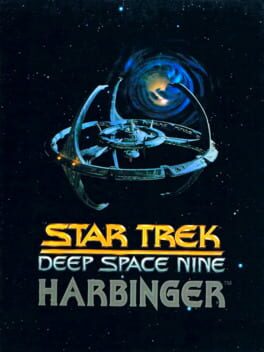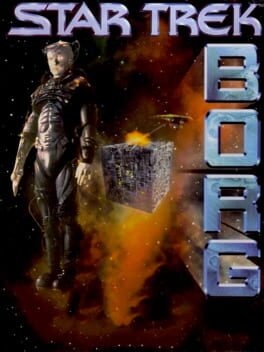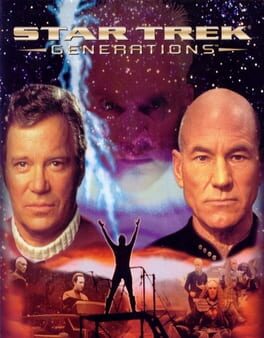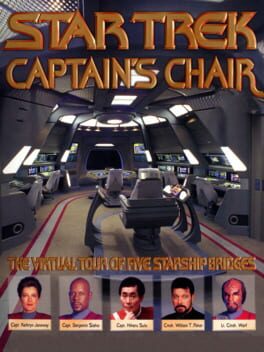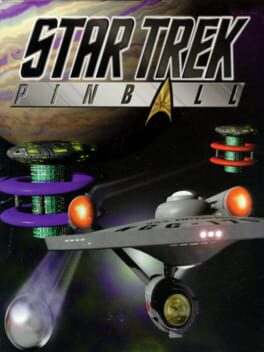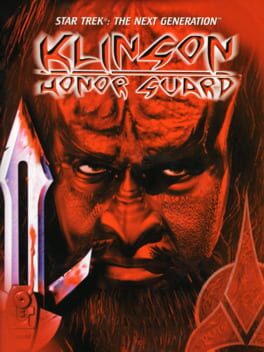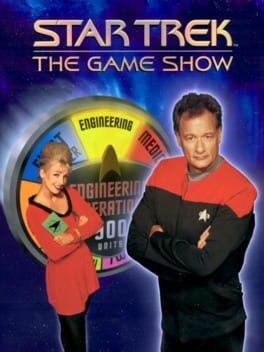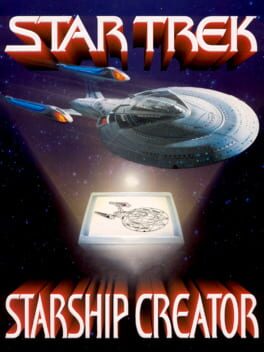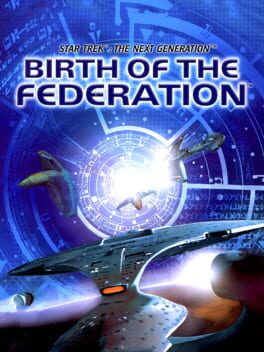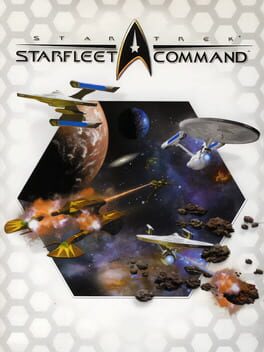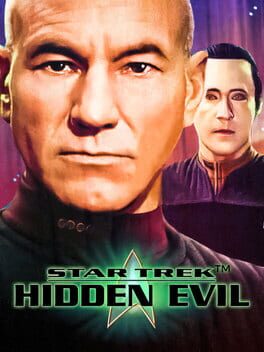Cube1701
DS9 Harbinger is a Myst-style adventure game. Each part of the level is made up of still images, with you clicking the edge of the screen to move around and turn in very limited places. This allows the game to look very impressive visually, especially in screenshots. The 3D models of the characters look impressive for the time and everyone is wonderfully voice acted, using the original cast of DS9.
You play a diplomat named Bannick, called to DS9 to assist an ambassador in speaking with a new alien race called the Scythians. These aliens speak in an unusual manner and nobody other than the ambassador has been able to figure it out. As you reach DS9, you get attacked by drones (in an impressive FMV cutscene) and crash land. The drones stat building up to attack DS9. To make matters worse, when you visit the ambassador you discover that he has been murdered. You need to solve the murder, work out how to talk to the Scythians and find a way to stop the drones.
The part of the game on DS9 is great (once you get your head around navigating the station), with lots of conversation options and an intriguing mystery. Puzzles are mostly self-enclosed, leaving you to focus more on the narrative mystery.
In a few parts of the game, you have to man the weapons of DS9 (and a runabout). These sections are just click to shoot, but are surprisingly difficult and not fun at all.
The latter half of the game, once you leave DS9, is much more of a challenging puzzle game like Myst, where you have to navigate a maze (not easy due to how you move, working out how to ger around DS9 was difficult enough), and is very much a chore, especially as you have large periods with no talking. That said, working out how to trick the AIs in charge and talking to them towards the ends is a lot of fun.
Unfortunately, they couldn’t get the full cast of DS9 for this game, so O’Brien and Bashir are said to be on a mission (Worf hasn’t joined the cast yet). You do get to spend plenty of time with Sisko, Odo, Dax, Quark and Kira, though, so there’s still a lot of interaction with the crew.
You play a diplomat named Bannick, called to DS9 to assist an ambassador in speaking with a new alien race called the Scythians. These aliens speak in an unusual manner and nobody other than the ambassador has been able to figure it out. As you reach DS9, you get attacked by drones (in an impressive FMV cutscene) and crash land. The drones stat building up to attack DS9. To make matters worse, when you visit the ambassador you discover that he has been murdered. You need to solve the murder, work out how to talk to the Scythians and find a way to stop the drones.
The part of the game on DS9 is great (once you get your head around navigating the station), with lots of conversation options and an intriguing mystery. Puzzles are mostly self-enclosed, leaving you to focus more on the narrative mystery.
In a few parts of the game, you have to man the weapons of DS9 (and a runabout). These sections are just click to shoot, but are surprisingly difficult and not fun at all.
The latter half of the game, once you leave DS9, is much more of a challenging puzzle game like Myst, where you have to navigate a maze (not easy due to how you move, working out how to ger around DS9 was difficult enough), and is very much a chore, especially as you have large periods with no talking. That said, working out how to trick the AIs in charge and talking to them towards the ends is a lot of fun.
Unfortunately, they couldn’t get the full cast of DS9 for this game, so O’Brien and Bashir are said to be on a mission (Worf hasn’t joined the cast yet). You do get to spend plenty of time with Sisko, Odo, Dax, Quark and Kira, though, so there’s still a lot of interaction with the crew.
1996
This is an interactive movie game, where you watch clips before being presented with a choice. Where you click on (or choosing not to click) will either end the game or let you proceed.
This is presented as a holonovel made by Gowron (Robert O’Reilly), where he wants to teach weaklings about how to be a true Klingon so you can be a worthy opponent. In the holonovel, you take the place as a Klingon boy on his Rite of Ascension when his father stops an assassination attempt on Gowron. You then embark on a journey to find out who is behind everything.
The game aspect of this is quite poor, as all but the right option lead to someone shouting at you and the game resetting to just before – the Borg game is much more creative in terms of using the interactive movie mechanic. The story, however, is interesting with some fun moments. It’s a good insight into Klingon culture. On YouTube, there are two ways of watching this: if you want to enjoy the story, you can watch the “correct path” version, which turns it into a fun Klingon episode of Star Trek. You can also watch a version with all the failure clips, with lots of wonderful overacting.
This is presented as a holonovel made by Gowron (Robert O’Reilly), where he wants to teach weaklings about how to be a true Klingon so you can be a worthy opponent. In the holonovel, you take the place as a Klingon boy on his Rite of Ascension when his father stops an assassination attempt on Gowron. You then embark on a journey to find out who is behind everything.
The game aspect of this is quite poor, as all but the right option lead to someone shouting at you and the game resetting to just before – the Borg game is much more creative in terms of using the interactive movie mechanic. The story, however, is interesting with some fun moments. It’s a good insight into Klingon culture. On YouTube, there are two ways of watching this: if you want to enjoy the story, you can watch the “correct path” version, which turns it into a fun Klingon episode of Star Trek. You can also watch a version with all the failure clips, with lots of wonderful overacting.
1996
The second interactive movie game. This follows Cadet Furlong who is being sent to a starbase ahead of a Borg invasion 10 years after the Battle of Wolf 359. Wishing he was fighting the Borg instead, as he lost his father at the Battle of Wolf 359, the cadet ends up being visited by Q. Q offers him a chance at saving his father and sends the cadet to the past, taking the place of the security officer and Q taking place of the medic.
The whole game is made up of live action footage, and John de Lancie gets plenty of screen time and is wonderful through the whole thing. The cast of new characters are also really good, too. At points in the “film” you get to make choices or solve puzzles, with Q resetting you if you mess up. I found that I much preferred picking the “wrong” options so I could see all the footage – you can never get tired of Q teasing you.
Because of Q resetting things, I think this works better than the Klingon game. I also really like that they make use of the bad choices as you sometimes need information from them to progress though the correct path.
There's a fan-made remaster called "Star Trek: Brog - Remastered" which upscales all the video and it looks amazing - check out that version.
The whole game is made up of live action footage, and John de Lancie gets plenty of screen time and is wonderful through the whole thing. The cast of new characters are also really good, too. At points in the “film” you get to make choices or solve puzzles, with Q resetting you if you mess up. I found that I much preferred picking the “wrong” options so I could see all the footage – you can never get tired of Q teasing you.
Because of Q resetting things, I think this works better than the Klingon game. I also really like that they make use of the bad choices as you sometimes need information from them to progress though the correct path.
There's a fan-made remaster called "Star Trek: Brog - Remastered" which upscales all the video and it looks amazing - check out that version.
A game that will be sharing a name with a Star Trek show. Starfleet Academy is sort of a reimagining of Starfleet Academy Bridge Simulator on SNES/32X, as it features the same style of gameplay and some of the same cadets, but with a new story, new characters and a completely different set of missions.
The first things that strikes you is the live action cutscenes. These often look odd as none of the actors were filmed on set, they were instead filmed separately and imposed onto the backgrounds. The cutouts can be very rough at times, but its somehow still very charming, especially as everyone is taking it seriously, including William Shatner, Walter Koenig, and George Takei in their last official live action appearances. You also get to make choices which impacts your ratings – if you don’t make the right ones, you won’t get to play a bonus mission at the end of the game.
The game uses a mixture of a joystick (or controller) and keyboard and it works quite well, even if it takes a bit of getting used to. It offers a lot more control than the SNES/32X games, but at the same time it also feels like you’re doing everything yourself instead of commanding a crew. The combat is still only forward phasers/torpedoes, but it feels a lot more fluid than any of the previous space combat, and it helped out by a full screen view that displays all needed information.
While this further separates you from the crew, it’s very much required for playing the game. The missions are almost entirely combat related, with a few where you can avoid encounters. None of the missions particularly stood out to me, other than one where you casually pass through the Galactic Barrier with a really nice cutscene.
Starfleet Academy is an interesting game, especially with the cutscenes. The gameplay can be frustrating at times (especially as you can very quickly have systems knocked out, a big pain if it’s impulse or weapons), but for the most part it’s fun to play.
The first things that strikes you is the live action cutscenes. These often look odd as none of the actors were filmed on set, they were instead filmed separately and imposed onto the backgrounds. The cutouts can be very rough at times, but its somehow still very charming, especially as everyone is taking it seriously, including William Shatner, Walter Koenig, and George Takei in their last official live action appearances. You also get to make choices which impacts your ratings – if you don’t make the right ones, you won’t get to play a bonus mission at the end of the game.
The game uses a mixture of a joystick (or controller) and keyboard and it works quite well, even if it takes a bit of getting used to. It offers a lot more control than the SNES/32X games, but at the same time it also feels like you’re doing everything yourself instead of commanding a crew. The combat is still only forward phasers/torpedoes, but it feels a lot more fluid than any of the previous space combat, and it helped out by a full screen view that displays all needed information.
While this further separates you from the crew, it’s very much required for playing the game. The missions are almost entirely combat related, with a few where you can avoid encounters. None of the missions particularly stood out to me, other than one where you casually pass through the Galactic Barrier with a really nice cutscene.
Starfleet Academy is an interesting game, especially with the cutscenes. The gameplay can be frustrating at times (especially as you can very quickly have systems knocked out, a big pain if it’s impulse or weapons), but for the most part it’s fun to play.
This game is definitely intriguing. It very loosely follows the story of Star Trek Generations, with Soren trying to destroy stars in order to change the path of the mysterious energy ribbon called the Nexus. In this game, Soren needs to destroy multiple starts to get what he wants, and you need to stop him – you can even prevent him from destroying the Amargosa star.
Most of the game is played in a first person view. The controls definitely feel very dated, but are one of the things that makes the game interesting. The directional buttons move forward/backwards and turns while the mouse aims the cursor. On the bottom of the screen, you control your inventory, scanning and map. The big square in the middle will show you objects you can interact with when you get close to them, which is a really nice touch. On the top of the screen, your phaser will aim at that part of the screen. It’s very different to the first person controls we’re used to now.
In these levels you’ll shoot through enemies and solve puzzles. Sometimes, you’ll even beam down in disguise and can do a lot before you have to resort to shooting. The graphics are extremely charming and are surprisingly nice to look at. When you get hurt a lot, you’ll be beamed up and the mission will have failed – however, you can fail a few missions before you lose the game.
Between missions, you’ll use Stellar Cartography to scan planets and stars in order to work out where you next have to go. You’ll also sometimes encounter enemy ships and use a pretty poor interface to fight them with. All the good parts are in the missions.
The missions are quite interesting. One has you infiltrate a Romulan base as Troi, one involves Crusher investigating a living planet and fighting giant antibodies (it reminds me a bit of the Voyager episode “Macrocosm” and the Chodak from Future’s Past/Final Unity even pop up.
Eventually, you’ll reach Veridian III. As Geordi is never captured in this game, things play out differently. Picard ends up in the Nexus (which is just a flashing blank screen as he asks Kirk for help), then Kirk delays Soren and falls off a bridge. Soren then beams to the Enterprise and initiates a warp core overload. After separating the saucer, Picard beams to the stardrive section and stops Soren from destroying the saucer (although he does enough damage that it has to crash land) before finding an escape pod with a sleeping Spot and watching the stardrive section blow up in a very impressive cutscene that looks like it’s actually using the studio models.
Although that’s not the only ending – you can actually fully defeat Soren. He brings a large fleet with him to Veridian III, but if you manage to disable his ship, he’ll self-destruct. The Enterprise D warps off unscathed and Kirk will still be in the Nexus.
Most of the game is played in a first person view. The controls definitely feel very dated, but are one of the things that makes the game interesting. The directional buttons move forward/backwards and turns while the mouse aims the cursor. On the bottom of the screen, you control your inventory, scanning and map. The big square in the middle will show you objects you can interact with when you get close to them, which is a really nice touch. On the top of the screen, your phaser will aim at that part of the screen. It’s very different to the first person controls we’re used to now.
In these levels you’ll shoot through enemies and solve puzzles. Sometimes, you’ll even beam down in disguise and can do a lot before you have to resort to shooting. The graphics are extremely charming and are surprisingly nice to look at. When you get hurt a lot, you’ll be beamed up and the mission will have failed – however, you can fail a few missions before you lose the game.
Between missions, you’ll use Stellar Cartography to scan planets and stars in order to work out where you next have to go. You’ll also sometimes encounter enemy ships and use a pretty poor interface to fight them with. All the good parts are in the missions.
The missions are quite interesting. One has you infiltrate a Romulan base as Troi, one involves Crusher investigating a living planet and fighting giant antibodies (it reminds me a bit of the Voyager episode “Macrocosm” and the Chodak from Future’s Past/Final Unity even pop up.
Eventually, you’ll reach Veridian III. As Geordi is never captured in this game, things play out differently. Picard ends up in the Nexus (which is just a flashing blank screen as he asks Kirk for help), then Kirk delays Soren and falls off a bridge. Soren then beams to the Enterprise and initiates a warp core overload. After separating the saucer, Picard beams to the stardrive section and stops Soren from destroying the saucer (although he does enough damage that it has to crash land) before finding an escape pod with a sleeping Spot and watching the stardrive section blow up in a very impressive cutscene that looks like it’s actually using the studio models.
Although that’s not the only ending – you can actually fully defeat Soren. He brings a large fleet with him to Veridian III, but if you manage to disable his ship, he’ll self-destruct. The Enterprise D warps off unscathed and Kirk will still be in the Nexus.
Another interactive CD-ROM, this time focusing on the bridges of the original Enterprise, Enterprise D, Defiant, Voyager and Enterprise E (plus a hidden Klingon Bird of Prey bridge). Each bridge has a lot of locations to view from (in 360 degrees) and you can zoom into every single panel on the bridge. Some of them have buttons you can press, and even a couple of simple games.
Sulu, Worf, Sisko, Janeway and Riker all give tours of the bridges, talking about each station. Janeway’s tour is the most fascinating, as it’s written from the perspective of before the ship launched, so the only other character mentioned is Harry Kim (none of the other people officially assigned to Voyager are part of the main cast). It’s also referred to “The Voyager” a lot, which sounds odd.
Sulu, Worf, Sisko, Janeway and Riker all give tours of the bridges, talking about each station. Janeway’s tour is the most fascinating, as it’s written from the perspective of before the ship launched, so the only other character mentioned is Harry Kim (none of the other people officially assigned to Voyager are part of the main cast). It’s also referred to “The Voyager” a lot, which sounds odd.
1998
A very basic pinball game. It features three tables (one exclusive to two players), which are designed to be like real life tables (though not based on actual ones) rather than taking advantage of being a video game. The tables are fairly generic and don’t really make much use of the Star Trek license other than imagery.
The two main tables both have the same problem – they have a ramp or button directly above the centre of the table, which means that the ball would very often just drop down the middle with no hope of stopping it.
The two main tables both have the same problem – they have a ramp or button directly above the centre of the table, which means that the ball would very often just drop down the middle with no hope of stopping it.
This game is an interesting bit of gaming history: the first game ever released using the Unreal engine, coming out before Unreal itself. It uses a beta version of the engine, so is quite buggy, and the gameplay often feels exactly like Unreal, as it’s a first person shooter that uses a lot of the same code – the movement, some level elements (such at mine carts attached to rails above them) and enemy AI are straight from Unreal.
You play as a new recruit for the Klingon Honor Guard when your training gets interrupted because the Klingon High Council has been bombed, with Gowron injured. Kurn (Worf’s brother, played by Tony Todd) and a Dahar Master send you on a quest to work out who is behind it. Naturally, this involves killing lots of enemies, which mainly consist of Klingons and Andorian pirates.
The graphics are good for the time, although most of the game is dark and full of browns, a lot of the levels merge together. A lot of levels are confusing mazes where you spend most of your time hunting for hard to see keys or buttons to progress. A few standout ones are set on space stations and ships. Because the structure is confined by the outside shape, the layouts make a lot more sense. The game has a lot of levels, and most of them end up merging together.
When not aimlessly walking around, the game is a lot of fun. Stabbing foes with a bat’leth is enjoyable, with lots of colourful blood spraying around (there are no humans in the game so it avoids having red blood). Most of the other weapons are fairly boring, with the exception of a disc weapon which launces a bouncing disc that destroys entire rooms of enemies. You can also find some gadgets to use, such as a deployable camera (never found a use for it) and mag boots, which are vital for going on spacewalks in some levels.
Klingon Honour Guard is fun in parts, but often frustrating. I feel like it goes on a bit too long, with the most enjoyable levels being close to each other in the middle of the game. It also doesn’t really capture the feel of the Star Trek universe. You see Klingons and Andorians, but they don’t really act like them. The main character also repeatedly shouts “I will cut you up like gach” at your foes, which I found odd because Klingons eat them alive, so there’s no cutting up.
You play as a new recruit for the Klingon Honor Guard when your training gets interrupted because the Klingon High Council has been bombed, with Gowron injured. Kurn (Worf’s brother, played by Tony Todd) and a Dahar Master send you on a quest to work out who is behind it. Naturally, this involves killing lots of enemies, which mainly consist of Klingons and Andorian pirates.
The graphics are good for the time, although most of the game is dark and full of browns, a lot of the levels merge together. A lot of levels are confusing mazes where you spend most of your time hunting for hard to see keys or buttons to progress. A few standout ones are set on space stations and ships. Because the structure is confined by the outside shape, the layouts make a lot more sense. The game has a lot of levels, and most of them end up merging together.
When not aimlessly walking around, the game is a lot of fun. Stabbing foes with a bat’leth is enjoyable, with lots of colourful blood spraying around (there are no humans in the game so it avoids having red blood). Most of the other weapons are fairly boring, with the exception of a disc weapon which launces a bouncing disc that destroys entire rooms of enemies. You can also find some gadgets to use, such as a deployable camera (never found a use for it) and mag boots, which are vital for going on spacewalks in some levels.
Klingon Honour Guard is fun in parts, but often frustrating. I feel like it goes on a bit too long, with the most enjoyable levels being close to each other in the middle of the game. It also doesn’t really capture the feel of the Star Trek universe. You see Klingons and Andorians, but they don’t really act like them. The main character also repeatedly shouts “I will cut you up like gach” at your foes, which I found odd because Klingons eat them alive, so there’s no cutting up.
A trivia game with some good production values, as it’s hosted by Q and Q. Q is played by John de Lancie with another Q as his sidekick (played by Karen Cornwell, this is her only acting role). All the questions and answers are read out, so there’s plenty of voice acting from the two, including plenty of quips. There’s even an annoying audience member that blurts out the answer if you run out of time. The quiz is split into four sections: Alpha Quadrant, Beta Quadrant, Gamma Quadrant and Delta Quadrant. The show covers TOS, TNG, DS9, Voyager and the movies.
In the Alpha Quadrant, the questions are about the characters in Star Trek. A wheel will spin and land on a division and you’ll be asked a question about someone from it. There’s plenty of variety and some interesting questions. In Beta Quadrant, the game reveals five clues one at a time and you need to type in the answer, either an alien race or a character’s name. The clues are quite well worded and there are some very obscure characters.
Gamma Quadrant focuses on command problems and how situations in the shows were solved. There’s also some interactivity as you can forfeit a question and send it to another player. Getting a question wrong will get you negative points in this round, so you don’t want to just guess.
The final round, Delta Quadrant, has five different styles, one chosen at random in each game, each loosely based on each of the shows (with the fifth representing the films).
While most of the questions are interesting and delve into a lot of deep Trek references, I did find one mistake: a question asks what Scotty used to construct the tank for carrying whales. Plexiglass wasn’t an option – instead the game wanted transparent aluminium (which Scotty traded the formula in order to get the Plexiglass).
Overall, this is a very entertaining trivia game.
In the Alpha Quadrant, the questions are about the characters in Star Trek. A wheel will spin and land on a division and you’ll be asked a question about someone from it. There’s plenty of variety and some interesting questions. In Beta Quadrant, the game reveals five clues one at a time and you need to type in the answer, either an alien race or a character’s name. The clues are quite well worded and there are some very obscure characters.
Gamma Quadrant focuses on command problems and how situations in the shows were solved. There’s also some interactivity as you can forfeit a question and send it to another player. Getting a question wrong will get you negative points in this round, so you don’t want to just guess.
The final round, Delta Quadrant, has five different styles, one chosen at random in each game, each loosely based on each of the shows (with the fifth representing the films).
While most of the questions are interesting and delve into a lot of deep Trek references, I did find one mistake: a question asks what Scotty used to construct the tank for carrying whales. Plexiglass wasn’t an option – instead the game wanted transparent aluminium (which Scotty traded the formula in order to get the Plexiglass).
Overall, this is a very entertaining trivia game.
This game lets you create your own starships. You start off with a popular starship class, such as Constitution, Galaxy, Intrepid or Defiant and then modify it in phases. The first phase is appearance, letting you toggle between different nacelles, hulls and saucers. Next up is the name, followed by internal systems that affect the stats.
One you’ve built a ship, you can send it on missions. The missions are fully automatic, so you just sit back and watch your creation at work (or put it in “stealth” mode and do something else).
While quite limited, it’s nice to see your creations flying around. I focused on three ships: the first was a Constitution class USS USS Columbia (I didn’t realise it automatically added the USS part), designed to look like a Constitution mixed with the NX class. Then a really silly looking Defiant, the Potato class USS Spud. Finally, a really cool looking Intrepid I called the USS Pathfinder.
One you’ve built a ship, you can send it on missions. The missions are fully automatic, so you just sit back and watch your creation at work (or put it in “stealth” mode and do something else).
While quite limited, it’s nice to see your creations flying around. I focused on three ships: the first was a Constitution class USS USS Columbia (I didn’t realise it automatically added the USS part), designed to look like a Constitution mixed with the NX class. Then a really silly looking Defiant, the Potato class USS Spud. Finally, a really cool looking Intrepid I called the USS Pathfinder.
Birth of the Federation is a turn based 4x strategy game (think of a turn-based Stellaris). You can play as the Federation (although it’s just humans), Klingons, Romulans, Cardassians of Ferrengi.
My first attempt ended in tragedy my science ship was lost to a neutron star pretty much straight away, then a major accident happened at another colony and I seemed to not have the dilithium required to build more. I used the game to learn the other parts of the game ready for the next game.
The start of the game is all about colonising systems, sustaining them (either manually or using the handy auto builder). Spacedocks are the most important element as they expand your reach, letting you colonise more star systems. Once you encounter other races, you can offer messages of peace, friendship, give gifts, demand goods or declare war. Unfortunately, the diplomacy is the weakest element. With the major races, it’s pretty much buying time before war, while with minor races if you’re lucky or throw enough money at them, you can get a system and possibly a couple of ships added to your faction as they join you.
There are two game types: control 60% of the galaxy or wipe out two factions that are set as your rivals. At some point, you’re going to need to take over systems owned by other factions, and you can only do so by wiping out all life in the system, which seems a bit overboard. This will anger other factions, so the game seems to be building up your recourses and ships enough to take on everyone near the end. The final part of the games (either winning or losing) seems anti-climatic, as it seems to be having a fleet bomb a defenceless planet.
Ship battles can be fought though a turn-based tactical screen, with some tactics working well over others. It mainly comes down to having more and better ships, though.
Birth of a Federation has a lot of depth, and I suspect would have been great when it came out. The genre has evolved a lot since then, so I wouldn’t recommend it now.
My first attempt ended in tragedy my science ship was lost to a neutron star pretty much straight away, then a major accident happened at another colony and I seemed to not have the dilithium required to build more. I used the game to learn the other parts of the game ready for the next game.
The start of the game is all about colonising systems, sustaining them (either manually or using the handy auto builder). Spacedocks are the most important element as they expand your reach, letting you colonise more star systems. Once you encounter other races, you can offer messages of peace, friendship, give gifts, demand goods or declare war. Unfortunately, the diplomacy is the weakest element. With the major races, it’s pretty much buying time before war, while with minor races if you’re lucky or throw enough money at them, you can get a system and possibly a couple of ships added to your faction as they join you.
There are two game types: control 60% of the galaxy or wipe out two factions that are set as your rivals. At some point, you’re going to need to take over systems owned by other factions, and you can only do so by wiping out all life in the system, which seems a bit overboard. This will anger other factions, so the game seems to be building up your recourses and ships enough to take on everyone near the end. The final part of the games (either winning or losing) seems anti-climatic, as it seems to be having a fleet bomb a defenceless planet.
Ship battles can be fought though a turn-based tactical screen, with some tactics working well over others. It mainly comes down to having more and better ships, though.
Birth of a Federation has a lot of depth, and I suspect would have been great when it came out. The genre has evolved a lot since then, so I wouldn’t recommend it now.
This ship combat game is based on the board game Star Fleet Battles (which licensed designs from Star Trek but is officially not Star Trek). This game has a lot to it. There are six races: Federation, Klingon, Romulans, Gorn, Lyran and Hydran, each with their own ships and campaign – every faction even has its own unique HUD and menu interface, a lot of effort clearly went into this game.
The same is true with the gameplay itself, there’s an immense amount of depth, so much you can do with how the weapons work, power distribution, using the transporter in offensive ways, having shuttles help you in combat and so much more. For someone who wants to feel like they’re fully managing a ship on their own, this is the kind of game for them. I personally did not enjoy it at all, with everything feeling extremely slow and sluggish, with battles feeling like endurance tests of not getting bored.
It’s not the game’s fault, really. It does what it sets out to do and does it well, it just really isn’t my kind of thing.
The same is true with the gameplay itself, there’s an immense amount of depth, so much you can do with how the weapons work, power distribution, using the transporter in offensive ways, having shuttles help you in combat and so much more. For someone who wants to feel like they’re fully managing a ship on their own, this is the kind of game for them. I personally did not enjoy it at all, with everything feeling extremely slow and sluggish, with battles feeling like endurance tests of not getting bored.
It’s not the game’s fault, really. It does what it sets out to do and does it well, it just really isn’t my kind of thing.
This was the first one that was a nightmare to get running. Even though it’s on GoG, it requires audio hardware acceleration to be turned off, which isn’t an option on Windows 11. In the end, I had to install Windows 10 on a partition to get it working. Was it worth it? Definitely not.
Hidden Evil starts out quite promising. You play as Ensign Sovok, a human that was raised by Vulcans and is the first human to have mastered the Vulcan neck pinch (which you use in the stealth sections of the game). He serves on a station near Ba’ku, that has discovered ancient ruins near where the Son’a are settling, and they have requested Picard to look into it.
Leaving the Enterprise E and everyone but Data behind Picard has Sovok take him to Ba’ku to investigate, although the Son’a soon start a rebellion.
The game is played form a stationary camera. The controls aren’t as bad as I expected, and worked well when mapped to a controller. Aiming isn’t easy, so you’ll just flail and spam the shoot button until you hit something. There’s a few basic puzzles, but most of the game is just roaming around, occasionally shooting things. There’s a lot of pointless back and forth and padding to the game – which is astonishing for a game that is shorter than Insurrection.
The plot starts to pick up when you discover one of the ancient beings: one of the aliens from The Chase. Then, just as things get interesting, she’s immediately disposed of and instead the real villain is revealed: a big organic blob that spews out insect soldiers. Given time, this thing could overrun the entire galaxy. Romulans take her and then you have two really boring missions aimlessly roaming corridors on a Romulan space station and the Enterprise E – somehow they made exploring the Enterprise boring (also, only Picard and Data still talk to you on the Enterprise).
Hidden Evil feels like a game that had big plans, but the developers didn’t have the budget to do what they want. As a result, it feels like they gave up on their own story half way through this short game.
Hidden Evil starts out quite promising. You play as Ensign Sovok, a human that was raised by Vulcans and is the first human to have mastered the Vulcan neck pinch (which you use in the stealth sections of the game). He serves on a station near Ba’ku, that has discovered ancient ruins near where the Son’a are settling, and they have requested Picard to look into it.
Leaving the Enterprise E and everyone but Data behind Picard has Sovok take him to Ba’ku to investigate, although the Son’a soon start a rebellion.
The game is played form a stationary camera. The controls aren’t as bad as I expected, and worked well when mapped to a controller. Aiming isn’t easy, so you’ll just flail and spam the shoot button until you hit something. There’s a few basic puzzles, but most of the game is just roaming around, occasionally shooting things. There’s a lot of pointless back and forth and padding to the game – which is astonishing for a game that is shorter than Insurrection.
The plot starts to pick up when you discover one of the ancient beings: one of the aliens from The Chase. Then, just as things get interesting, she’s immediately disposed of and instead the real villain is revealed: a big organic blob that spews out insect soldiers. Given time, this thing could overrun the entire galaxy. Romulans take her and then you have two really boring missions aimlessly roaming corridors on a Romulan space station and the Enterprise E – somehow they made exploring the Enterprise boring (also, only Picard and Data still talk to you on the Enterprise).
Hidden Evil feels like a game that had big plans, but the developers didn’t have the budget to do what they want. As a result, it feels like they gave up on their own story half way through this short game.
2000
A real time strategy game set after the Dominion war. The story starts with the Enterprise E dealing with Dominion stragglers that refuse to accept that the war is over when a ship from the future comes and warns Picard that the Borg are about to launch a large scale invasion led by Locutus. At the same time, infighting starts out with the Klingons and Romulans – if this doesn’t stop, the alpha quadrant is doomed.
Armada is a fairly basic RTS game. Each playable faction -the Federation, Klingons, Romulans and Borg – plays almost identically as they all have the same stations and types of ships, they just look different and have slightly different abilities. Building your forces is the same for all of them, although it does make them more balanced against each other, even if it means a Borg Cube is on par with a Sovereign class ship.
The main unique element of Armada is crew. Each ship has its own crew, and the number drops down in battles and become less effective. You can also transport your crew to other ships. Derelict ships can be scattered around to take over, and you can even gain control of enemy ships. It’s a really nice mechanic, even if everyone breeds at an alarming rate.
The missions in the story mode have thought out some interesting scenarios to play, which keeps things varied. Some are about defending, some are building up forces to attack, while some have more unique objectives. There’s one where you start off with just a Defiant class ship and need to navigate a maze of asteroid while being chased by far more powerful ships, using derelict ships as cannon fodder to reach the end of the maze.
The game looks very nice, and there are some interesting cutscenes throughout the campaign. It makes things less realistic to make the game much more fun to play – like the layouts of the maps, which manage to remain interesting even though they’re in space. While basic, it’s a lot of fun.
Armada is a fairly basic RTS game. Each playable faction -the Federation, Klingons, Romulans and Borg – plays almost identically as they all have the same stations and types of ships, they just look different and have slightly different abilities. Building your forces is the same for all of them, although it does make them more balanced against each other, even if it means a Borg Cube is on par with a Sovereign class ship.
The main unique element of Armada is crew. Each ship has its own crew, and the number drops down in battles and become less effective. You can also transport your crew to other ships. Derelict ships can be scattered around to take over, and you can even gain control of enemy ships. It’s a really nice mechanic, even if everyone breeds at an alarming rate.
The missions in the story mode have thought out some interesting scenarios to play, which keeps things varied. Some are about defending, some are building up forces to attack, while some have more unique objectives. There’s one where you start off with just a Defiant class ship and need to navigate a maze of asteroid while being chased by far more powerful ships, using derelict ships as cannon fodder to reach the end of the maze.
The game looks very nice, and there are some interesting cutscenes throughout the campaign. It makes things less realistic to make the game much more fun to play – like the layouts of the maps, which manage to remain interesting even though they’re in space. While basic, it’s a lot of fun.
A third person shooter set sometime in season 6 of Deep Space Nine. Most of the main characters are involved, with three playable: Sisko, Kira and Worf. Unfortunately, not all the cast is here, with Avery Brooks and Colm Meaney not returning. The voice actor for Sisko isn’t too bad (although still noticeable), while O’Brien is someone doing a very bad Irish accent.
That said, the story is really good. The new alien race, the Grigari are introduced in a spooky manner. They have shielding that needs scanning so you can modulate your phaser to the right frequency, and there’s some nice locations that you visit. The ploy revolves around Pah-Wraith orbs after some Cardassian bodies from a failed experiment are discovered.
While the gameplay is mainly shooting, the tricorder is used well for scanning enemies, looking for hazards and solving puzzles. It help keeps the game feeling like it belongs in Star Trek. The shooting mechanics and weapons are quite fun too, and the game plays really well mapped to a controller (using external software). There’s also some rudimentary platforming, which works well enough. It’s a very fun game.
My favourite mission involves investigating a crashed Miranda class starship. Even with the old graphics, climbing up a cliff and seeing the ship is a wonderful sight, and you even get to fight on top of it and explore inside. You also get to explore parts of the Defiant and between each mission, explore parts of Deep Space Nine, talking to the main cast and some recurring characters, including Garak. That said, some character’s faces are really not done well – I thought Jazdia Dax was Odo when I first saw her. Worf and the Cardassians look much better than the humans in this game.
You can also play through the game as Kira and Worf. Kira has a unique mission on Bajor, but misses out on the crashed Miranda ship. You play though the same levels, but take different routes and have different objectives (although some sections are still completely the same). Kira plays the same as Sisko, while Worf lacks a phaser (which also means no forcefields to bypass) so if you don’t have ammo, you need to get up close and personal with a Bat’leth.
Deep Space Nine: The Fallen is a really fun game, I definitely recommend this one.
That said, the story is really good. The new alien race, the Grigari are introduced in a spooky manner. They have shielding that needs scanning so you can modulate your phaser to the right frequency, and there’s some nice locations that you visit. The ploy revolves around Pah-Wraith orbs after some Cardassian bodies from a failed experiment are discovered.
While the gameplay is mainly shooting, the tricorder is used well for scanning enemies, looking for hazards and solving puzzles. It help keeps the game feeling like it belongs in Star Trek. The shooting mechanics and weapons are quite fun too, and the game plays really well mapped to a controller (using external software). There’s also some rudimentary platforming, which works well enough. It’s a very fun game.
My favourite mission involves investigating a crashed Miranda class starship. Even with the old graphics, climbing up a cliff and seeing the ship is a wonderful sight, and you even get to fight on top of it and explore inside. You also get to explore parts of the Defiant and between each mission, explore parts of Deep Space Nine, talking to the main cast and some recurring characters, including Garak. That said, some character’s faces are really not done well – I thought Jazdia Dax was Odo when I first saw her. Worf and the Cardassians look much better than the humans in this game.
You can also play through the game as Kira and Worf. Kira has a unique mission on Bajor, but misses out on the crashed Miranda ship. You play though the same levels, but take different routes and have different objectives (although some sections are still completely the same). Kira plays the same as Sisko, while Worf lacks a phaser (which also means no forcefields to bypass) so if you don’t have ammo, you need to get up close and personal with a Bat’leth.
Deep Space Nine: The Fallen is a really fun game, I definitely recommend this one.
